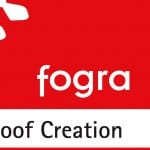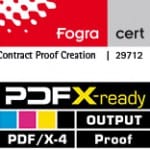“We print 135gr/sqm on a Berberich Allegro. Can you make us a proof on this paper? Can you proof on our final production paper?”
Our telephone support often asks for a proof on production paper. Unfortunately, we always have to answer the question negatively. I would like to briefly explain the reasons for this in the following article.
Proofing on production paper is still technically impossible.
All proofing systems currently certified by Fogra are based on an inkjet printer as a test printer, mostly from Epson, Canon or HP. These printers are characterised by a large colour space, good resolution and excellent homogeneity and colour stability – all characteristics that are absolutely necessary for a proof printing system. The Epson systems used by the majority of proof printers are based on 11-colour pigment inks, which can reproduce a significantly larger colour space than e.g. ISOCoatedV2. However, the prerequisite for this is the use of special papers optimized for inkjet printing, in which the pigments and inks are optimally emphasized. This requires special coatings that are optimized for optimum reproduction, fast drying, good abrasion resistance and high UV stability of the print. On an image printing paper without these coatings, the ink would run, hardly dry and would not be smudge-proof. The color space would also be impossible to achieve. A proof would therefore not be possible from this point of view.
Stamp once on a coated printing paper. You can easily wipe off the stamping ink even after many days. The situation is similar with inkjet inks. And even colour laser printers are no solution. The toner applied to the paper in these systems and then liquefied by heat to bond with the paper cannot penetrate the closed coated surfaces. This means that the print is not fused and the toner can be wiped off the surface directly after printing.
Modern digital printing systems such as the iGen from Xerox are also capable of neatly mapping color spaces such as ISOCoatedV2. Some of these systems are also able to print offset papers properly, although here too special papers optimized for digital printing are used. However, despite major improvements in recent years, these digital printing systems are still not capable of reproducing the small color deviations required for a true color-accurate proof, a “contract proof in accordance with ISO 12647-7”. Even after a complete recalibration and re-profiling on the paper used, these systems only achieve “Validation Print” quality according to ISO 12647-8.
“Validation Prints” are not “contract proofs”, they are not color-binding and not legally binding, since the permissible color deviations of Validation Prints may be significantly higher than those of real proofs. The result would therefore only be a “print”, which is not binding for a print shop as a result, not “color-binding” but only “colored goods”. And it is precisely this commitment that must be achieved with a proof. In addition, the color stability of these systems is predominantly so critical that even with a new profiling in the morning in the afternoon, even the lax validation print tolerances can no longer be achieved and the system again has to be recalibrated and profiled.
The only solution: the classic proof. If it wasn’t for the cost.
Here, real offset printing with real colours produces the real print later in an edition of one piece. Since the proof is printed in real offset printing, production paper can also be used here without any problems. The downside? The price. Depending on the format, a proof on circulation paper costs several hundred euros. Since press proofs are still predominantly film-based printed today, but the real printing is usually via computer-to-plate printing plates, there is no 100% precision of the press proof for the production print today either. CTP is also available from proofing companies, but at an even higher cost. A little postcard, a slim fanfold? This is not economically viable in proof printing.
So don’t use circulation paper for shorter print runs. Especially with ISOCoatedV2, a classic proof offers you true color accuracy and stability at very low costs. Just lay the cover paper next to it. We are sure that this is the best way for you to imagine what the subsequent printing will look like, in the “most colour-accurate” and also at the best price. And in comparison to Validation Print digital printing, it is legally binding and binding in colour.

The Proof GmbH has again successfully completed Fogra certification for the production of contract proofs – Contract Proof Creation. The certification proofs have been produced both on EPSON 7900 and EPSON 9900 proof printers with SpectroProofer measuring instruments. Our two proofing papers were included in the certification process. Proof GmbH is therefore certified for the most frequently used Proofing Standards. The requirements for the Fogra certification go far beyond simply measuring the media wedge. So the proofs are analyzed according to the following criteria: Compliance with the tolerances of the … read more

Once again we passed the Fogra certifications and were even the first company to be certified with the Fogra “Spot cert” for Fogra59 eciCMYK-V2.

EAN codes are standard on every product today. While in the good old days, shopowners themselves typed the prices into a cash register by hand, today scanner cash registers are the rule, which scan standardized EAN codes with a laser and thus clearly recognize the article and add it to the receipt. EAN, by the way, stands for “European Article Number” and was replaced in 2009 by the global GTIN, “Global Trade Item Number”. The EAN or GTIN is a barcode that can be read automatically and read by barcode … read more

Even almost 9 years after the introduction of the successor colour space PSOCoatedV3, ISOCoatedV2 / FOGRA39 is still the most widespread colour space in Europe. We at Proof GmbH count around 200 jobs from time to time for the German Printing and Media Industries Federation, among others. In the last count, proofs in ISOCoatedV2 accounted for around 68% of all proof jobs at our company. This is a clear sign of the continued widespread use of the colour space. ISOCoatedV2: From the classic colour space to the beacon of the … read more

Digimarc is a digital watermark that can be used to embed information in images, videos or other media. Digimarc watermarks are invisible to the human eye, but remain recognisable to special software or devices. Digimarc is becoming increasingly popular in the packaging sector in particular, as this technology allows the digits of the EAN barcode and more to be applied invisibly to all areas of the packaging. Digimarc and EAN barcode at the supermarket checkout When scanning at the checkout, the checkout staff do not have to search for the … read more

Proof GmbH has again been certified by Fogra in September 2015, this time for the standards Fogra 51 (PSOCoated_v3), Fogra 52 (PSOuncoated_v3) and Fogra 39 (ISOcoatedv2). The Proof GmbH has thus reaffirmed it’s quality by the strict criteria of Fogra. The tests Fogra conducted went far beyond the pure colorimetric readout of a media wedge. The special proofs for Fogra were evaluated among the following criteria: Color accuracy of the Ugra / Fogra media wedge CMYK 3 Overall color accuracy and gamut Uniformity and homogeneity of the proofsProof GmbH has again been certified … read more

Offset and Newsprint ISO Coated v2 (ECI) / ISO Coated v2 300% (ECI) Profile: ISOcoated_v2_eci.icc Standard for glossy and matte coated paper Paper: Types 1 and 2, gloss and matte coated Tone value increase curves A (CMY) and B (K) as defined in ISO 12647-2:2004 Characterisation Data: FOGRA39L ISOUncoated Profile: ISOUncoated.icc Standard for uncoated white natural paper Paper: paper grade 4, uncoated white offset, dot gain curves C (CMY) and D (K) from ISO 12647-2: 2004 Characterisation Data: FOGRA29L PSOCoatedV3 / Fogra 51 Profile: PSOcoated_v3.icc The successor of ISOCoatedV2 for glossy … read more

In this short image video we – the Proof GmbH – introduce us and our work. Find out who we are and what drives us. What do you think of our short film?

Due to our involvement with freeColour e.V., at the last meeting in Switzerland the desire for a cross-media tool for designers was expressed with which one can create intersections of colourspaces from the freieFarbe CIELAB HLC Colour Atlas XL. With Gamutmap, Proof GmbH has now created such a tool, which is available to all designers free of charge. With Gamutmap nearly 100 individual colour spaces can be indicated from 34.250 colours of the entire CIELAB colour space, or intersections from many combined colour spaces can be indicated. An example: As … read more

The Proof GmbH provides proofs for Scheufelen Heaven 42 papers on the new EFI 8245 OBA proofing paper. With this new proofing paper it is now possible to proof the bright-white paper dye of Heaven42l. With Heaven 42 a bright white paper was developed by the German paper company Scheufelen, which opened up a new color whiteness. Especially technical motifs (shades of gray, silver tones from 4c, strong contrasts) act on Heaven 42 particularly brilliant and neutral. With an unchanged separation (eg with ICC profile “ISOcoated_v2”), but the printed image with the … read more









